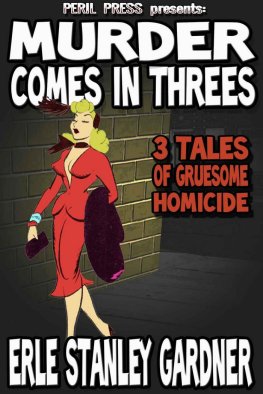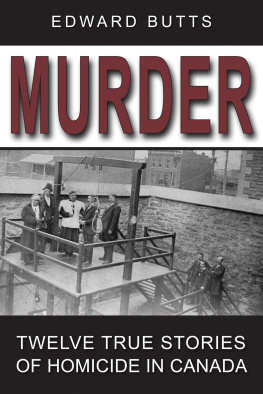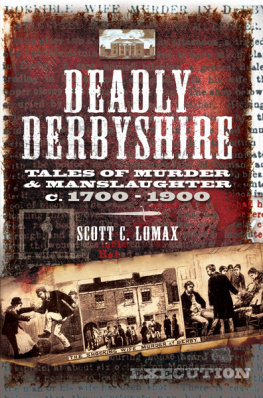First published 2005 by Transaction Publishers
Published 2017 by Routledge
2 Park Square, Milton Park, Abingdon, Oxon OX14 4RN
711 Third Avenue, New York, NY 10017, USA
Routledge is an imprint of the Taylor & Francis Group, an informa business
Copyright 2005 by Taylor & Francis.
All rights reserved. No part of this book may be reprinted or reproduced or utilised in any form or by any electronic, mechanical, or other means, now known or hereafter invented, including photocopying and recording, or in any information storage or retrieval system, without permission in writing from the publishers.
Notice:
Product or corporate names may be trademarks or registered trademarks, and are used only for identification and explanation without intent to infringe.
Library of Congress Catalog Number: 2005050592
Library of Congress Cataloging-in-Publication Data
OKane, James M.
Wicked deeds: murder in America/James OKane
p. cm.
Includes bibliographical references and index.
ISBN 0-7658-0289-9 (alk. paper)
1. MurderUnited States. 2. ManslaughterUnited States. I. Title.
HV6529.O53 2005
364.15230973dc22
2005050592
ISBN 13: 978-0-7658-0289-7 (hbk)
Dedicated To
My Wife Marge
My Children and their Spouses
J.B. and Julie
Dan
Pat and Charity
Joe and Michele
Mary Rose
My Grandchildren
Mary Alina
Caitlin
Christine
J.P.
Michael
Tiernan
Now Abel was a keeper of the flocks and Cain a tiller of the soil. In the course of time Cain brought to the Lord an offering of the fruit of the ground. Abel also brought some of the firstlings of his flock with their fat portions. The Lord was pleased with Abel and his offerings; but for Cain and his offering he had no regard. Cain was very angry and downcast. The Lord said to Cain, Why are you angry and why are you downcast? If you do well, will you not be accepted; but if you do not do well, will not sin crouch at the door! Its desire is for you, but you must master it.
Cain said to his brother Abel, Let us go out into the field. Now when they were in the field, Cain turned against his brother Abel and slew him. Then the Lord said to Cain, Where. is your brother Abel? He answered, I do not know. Am I my brothers keeper? And the Lord said, What have you done? The voice of your brothers blood cries to me from the ground. And now cursed are you in the soil which has opened its mouth to receive your brothers blood from your hand. When you till the soil, it shall not give its fruit to you; a fugitive and a wanderer shall you be on the earth. Cain said to the Lord, My punishment is too great to bear. You are driving me today from the soil; and from your face I will be hidden. And I shall be a fugitive and a wanderer on the earth, and whoever finds me will kill me. But the Lord said to him, Not so! Whoever kills Cain shall be punished sevenfold. Then the Lord gave Cain a token so that no one finding him should kill him. And Cain went out from the presence of the Lord in the land of Nod, to the east of Eden.
Genesis 4:216
Wicked Deeds could not have been written without the assistance of dozens of people who aided me in every step of its conceptualization and writing.
Foremost thanks goes to my wonderful wife Marge, and my children J.B., Dan, Pat, Joe and Mary Rose; all listened to, discussed, and argued with me about various aspects of murder in general, and specific cases in particular. Though probably baffled by my interest in such a macabre topic, each encouraged me at every step in the books composition.
Various police officers provided me with valuable insights into the homicide scenarios. Foremost among these are the detectives from New York Police Departments Brooklyn North Homicide Task Force, particularly Detective Paul Weidenbaum (deceased), and Detective Dave Carbone both of whom became not only great sources of information, but close friends as the years went by. Both provided to me their immense accumulated knowledge drawn from the hundreds of murders they had investigated in their NYPD careers. Extremely helpful also were my brother-in-law, Tom Moran, Palm Beach, Florida, Police Department, Bob Creighton, a close friend of thirty years and former Commissioner of Police for Suffolk County, New York, and current Chief Investigator for the D.A.s office of that county, and Jim Trahon, a good friend and neighbor, now with the Boston office of the FBI. All have been great observers of the human condition and the reality of homicide, which they discussed with me on many enlightening occasions.
Numerous other law enforcement personnel also assisted my efforts in locating specific interesting cases, some of which were quite bizarre. Included here are the following: Sheriff Robert Foerster, Richmond County, Illinois; Detective Anthony Yoakum, Upland, California Police Department; Detective Chris Kearns, Allegheny County, Pennsylvania, Homicide Division; Detective Charles Brown, Sparta, Michigan, Police Department; Detective A.E. Black, Tampa, Florida, Homicide Division; Robert Anderson, Prosecutor, Loudan County, Virginia; and John Zakowski, District Attorney, Brown County, Wisconsin.
My good friend, Dr. Ron Suarez, Chief Medical Examiner, Morris County, New Jersey provided me with an in-depth look at the homicide act itself as he recounted to my Drew University criminology classes the actual process of death by homicide. Phyllis Schultze, Chief Librarian of the Rutgers University School of Criminal Justice, went out of her way to provide the resources of her disposal that helped me enormously in researching homicide. So also did three of my former students: Andy Baron, a former Assistant Prosecutor, Middlesex County, New Jersey; Lou Fasulo, former Supervising Attorney for the Legal Aid Society, New York City; and Laura Hook, Prosecutor Sex Crimes-Domestic Violence unit of the Union County, New Jersey, Prosecutors office. All not only helped me in myriad ways but also made me so thankful that I chose a teaching career at Drew University where I had the privilege of knowing them as students and learning from them.
Special thanks should be extended to Drew University for providing release time and research funds that helped me considerably in completing this project. I am deeply grateful to the following colleagues at Drew who aided me in countless ways: Vice President Paolo Cucchi; Professors Phil Jensen, Roxanne Friedenfels, Merrill Skaggs and Paul Wice. Also to be thanked are not only my student assistants who aided me in my research Liz Mullarkey, Vic Macam, Molly Schulman, Katherine Girard, Mike Grohowski, Alexis Ramirez-Arnold, Rob Davelis, Liz Vail, Sarah Sampson, and Anne Dorrance, and other Drew staff who helped me formulate my ideas Neil Clark, Lydia Feldman and Scott Wood. Two former Drew colleagues, Jeff Cromarty and Mike Meagher, assisted me in formulating the conceptual framework of the book and aided me in the initial writing of it. So also did Buzz and Kris McLaughlin, close friends who politely prodded me to complete it in a timely fashion, supporting me at every step with their kind encouragement and actual enthusiasm about the work in progress. I am also deeply indebted to Bob Lynch, a Professor of Humanities, New Jersey Institute of Technology, a life-long friend who did a magnificent job in helping edit the manuscript. His objective comments and corrections provided me with a wealth of ideas about the structure and composition of the manuscript. So also did Professor Jim Mills, Drew University, who proved invaluable in helping with the layout of the work. Jim Gray, Dan and Mary OKane, Helen and Bob Grubbs, Linda and Greg Pasternak, Peter Signiorelli, John Caporaso, Steve Huvane, John Guegan, Mark Young, Harvey and Leslie Weinberg deserve special thanks for their advice and encouragement; each provided me with interesting cases, timely data, and frequent insights into the act of homicide.








